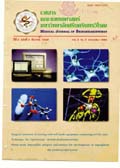Human Herpesvirus 6
Keywords:
Human Herpesvirus 6Abstract
Human herpesvirus 6 (HHV-6)เป็นสมาชิกใหม่ของ family Herpesviridae การติดเชื้อครังแรกทำให้เกิดโรคไข้ออกผื่นชื่อ exanthem subitum (roseola infantum)ในเด็กเล็กที่มีอายุระหว่าง 6 -24 เดือน หลังการติดเชื้อครั้งแรก HHV-6 จะทำให้เกิดการติดเชื้อแอบแฝงในร่างกายของผู้ติดเชื้อได้เหมือนกับ herpesviruses ชนิดอื่นๆ และอาจถูกกระตุ้นให้มีการเจริญเพิ่มขึ้นใหม่ได้โดยปัจจัยบางอย่าง ซึ่งยังไม่ทราบแน่ชัดเซลล์เป้าหมายของการติดเชื้อ HHV - 6 คือ T-lymphocyte ที่มี CD4 อยู่บนผิวเซลล์เหมือนกับเซลล์เป้าหมายก่อไวรัสก่อโรคเอดส์ (human immunodeficiency virus,HIV) พบว่า HHV-6 มักมีการติดเชื้อร่วมกับผู้ป่วยที่มีความปกติของระบบภูมิคุ้มกันและอาจทำให้ผู้ป่วยมีอาการรุนแรงขึ้นได้ เช่น ผู้ป่วยที่ได้รับการปลูกถ่ายอวัยวะ, ผู้ป่วยเอดส์และผู้ป่วยมะเร็งบางชนิด จึงเป็นไปได้ว่า HHV-6 อาจถูกกระตุ้นให้มีการเจริญเพิ่มจำนวนขึ้นมาใหม่ในผู้ป่วยเหล่านี้ ปัจจุบันยังไม่ทราบข้อมูลที่แน่ชัดในหลายๆด้าน เช่น พยาธิกำเนิดและติดต่อของ HHV-6, การรักษาโรคติดเชื้อ HHV-6 และเซลล์ที่ HHV-6 เข้าไปแอบแฝงอยู่ เป็นต้น การศึกษาในอนาคตจะช่วยทำให้ข้อมูลเหล่านี้มีความกระจ่างมากขึ้นและเป็นประโยชน์ต่อไป
Human herpesvirus 6 (HHV-6) is a new member of the family Herpesviridae. HHV - 6 has been identified as the etiologic agent of exanthem subitum (roseola infantum) in childen (6 -24 months) with primary infection. Like other herpesviruses, HHV - 6 causes a latent infection after primary infection and can be reactivated by some factors which are the same as those of HIV (human immunodeficiency virus). HHV-6 infection is found in association with immunocompromised patients such as organ transplant patients, AIDS patients and some carcinoma patients, and may cause some complications to these patients. The knowledge about the pathogenesis, transmission, therapy of HHV-6 and cells which is latently infected by HHV-6 are still inconclusive and need more investications in the future.



